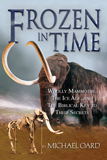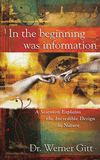News to Note, May 2, 2009
A weekly feature examining news from the biblical viewpoint
Darwin’s got the flu, a wimpy asteroid, CSI: Ice Age, and more!
1. Swine Flu Is Evolution?
Swine flu—both the virus itself and the associated paranoia—seems to be sweeping the world. Is it evolution in action?
2. The Wimpy Asteroid
The widely taught model of dinosaur extinction doesn’t line up with the latest fossil findings.
3. National Geographic News: “Baby Mammoth CT Scan Reveals Internal Organs”
The preserved baby woolly mammoth shows that it died in an “oxygen-deprived environment” that “prevented decay and kept it intact.” Catastrophic processes, perhaps?
The mammoth, discovered last year in Russia, appears to have been only three to four months old when it died. CT scans conducted in Japan produced 3-D images of the mammoth’s internal organs, giving researchers their best information to date about the internal structure of mammoths.
What’s intriguing is how the mammoth appears to have perished. “The last movements of the trunk and its last breathing was bringing a lot of silt inside,” explains researcher Alexei Tikhonov of the mammoth’s death. National Geographic News’s James Owen writes, “It’s thought the Ice Age mammal met its end suddenly, when it drowned in a river or a lake, as its trunk, mouth, and digestive tract contained large amounts of mud.”
This certainly fits the scenario for how a catastrophic flood could drown and bury animals in sediments. Of course, because this mammoth was found at the top of the sedimentary layers (actually in permafrost), it would have been the result of a local flood some time after Noah’s Flood, presumably during the Ice Age. Alternatively, this mammoth may have simply been caught in a bog and unable to escape (again, during the Ice Age).
Look to AnswersInGenesis.org early next week for a more detailed review of the baby mammoth.
For more information:
4. Molucules Don't Make the Man
Scientists have built a molecular system that “evolves” in the lab. But like other such systems that have gone before it, this doesn’t prove Darwin.
5. ScienceNOW: “Safer Stem Cells?”
Week after week, we’ve been reporting on breakthroughs in non-embryonic stem cell research—breakthroughs that show the superior viability of such life-honoring medical treatments.
In this case, the breakthrough concerns the process through which scientists convert adult body cells into so-called pluripotent stem cells, able to grow into many types of human tissue.
Previously, the process required the use of viruses to insert genetic material into the adult stem cells to activate the pluripotency. Of course, even to a layman that sounds dangerous; furthermore, there was medical fear that this method may trigger cancer in the implanted stem cells.
The breakthrough was the result of work by Scripps Research Institute chemist Sheng Ding, who—along with colleagues—figured out how to insert the necessary transcription factors without using a virus. The team experimented on mice cells and in live mice, demonstrating that the resulting stem cells are fully pluripotent.
While the method is less efficient than using viruses, the risks should be much lower. The researchers also caution that the method will have to be tested in humans.
For more information:
And Don’t Miss . . .
- You may think that “hundreds of years” is the language of (catastrophist) creationists while “millions of years” is the language of (uniformitarian) evolutionists. However, a new study shows that even evolutionists are willing to believe in rapid deglaciation in just hundreds of years—compatible with a single, post-Flood Ice Age.
- The New York Times tells us about atheists “shouting it from the rooftops”—the increasing vocalness and pride of atheists across America. The Times reports that atheists are increasingly meeting up and organizing, even likening themselves to a “rights movement” and “coming out of the closet.” The irony is that atheists, such as Beverly Long (quoted in the article) commonly report hiding their concerns when growing up in church. For a movement that proclaims rationality and open-mindedness, we wonder how many left church without ever seeking answers to their questions. (See also a map attached to the article that shows how atheism is growing in the United States.)
- A new DNA study “[v]irtually without exception” supports the hypothesis that all Native Americans are descended from a single ancestral group that emigrated from Asia across the Bering Strait. (For more, see our coverage of the same hypothesis in the December 1, 2007 and March 15, 2008 issues of News to Note.)
- Dinosaurs did indeed live in what we now call the Arctic. Answers in Genesis covered this last year in Polar Dinosaurs.
- Vote for the greatest current scientific mystery in a poll at LiveScience. We (of course) wanted to point out that staunchly evolutionistic LiveScience included “How Did Life Arise on Earth?” in the poll, and as we’re writing this “How Did the Universe Begin?” is the top question. (We answered “What Causes Gravity?”—a good, operational science question for physicists, including creationist physicists.)
- If you thought evolutionists had already applied “evolution” to everything, think again: an engineer and a biologist are studying how “flow systems . . . evolve in time to balance and minimize imperfections” (our emphasis). It reminds us of mineral evolution last year.
- A spider with a smiley face—natural selection at work or intelligent design? While some may speculate that this is an example of God’s sense of humor, the fact that not all of this species of spider have such markings mean the smiley face is probably a chance occurrence.
- Comets delivered the ingredients to start life on Earth? Despite what the article says, it’s an old idea—made none the more plausible by the new research, which merely speculates how comets could have delivered the same noble gases that we have in Earth’s atmosphere now.
For More Information: Get Answers
Remember, if you see a news story that might merit some attention, let us know about it! (Note: if the story originates from the Associated Press, FOX News, MSNBC, the New York Times, or another major national media outlet, we will most likely have already heard about it.) And thanks to all of our readers who have submitted great news tips to us. If you didn’t catch all the latest News to Know, why not take a look to see what you’ve missed?
(Please note that links will take you directly to the source. Answers in Genesis is not responsible for content on the websites to which we refer. For more information, please see our Privacy Policy.)
Recommended Resources

Answers in Genesis is an apologetics ministry, dedicated to helping Christians defend their faith and proclaim the good news of Jesus Christ.
- Customer Service 800.778.3390
- © 2025 Answers in Genesis





